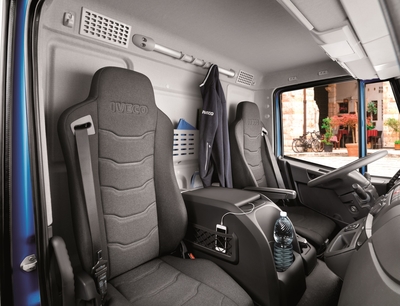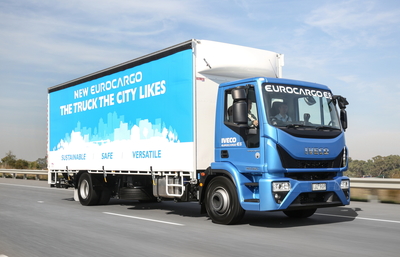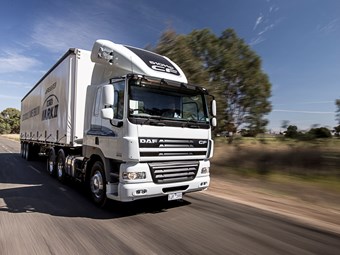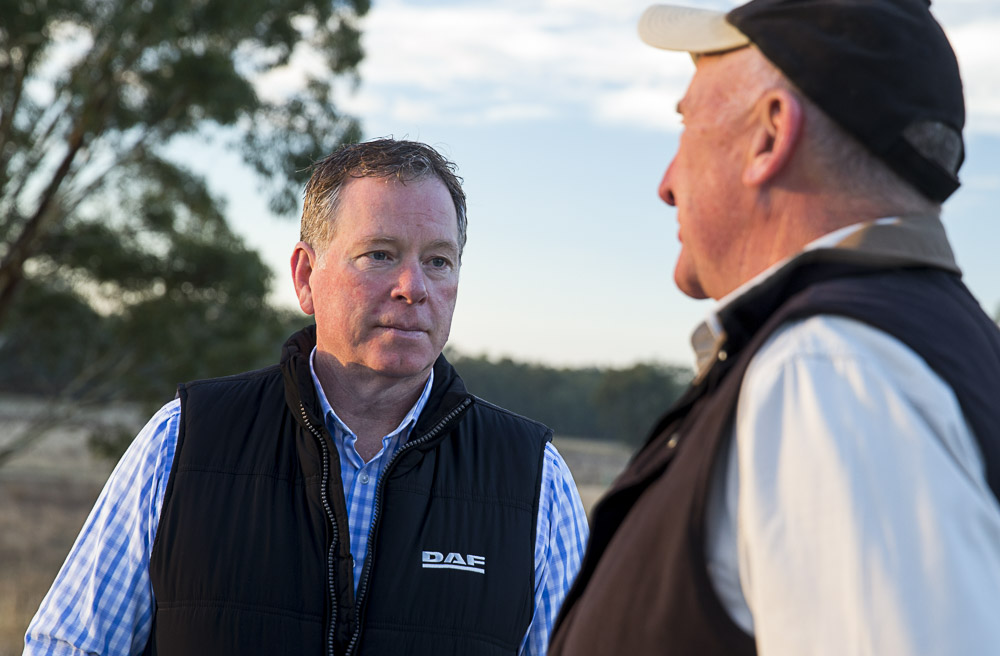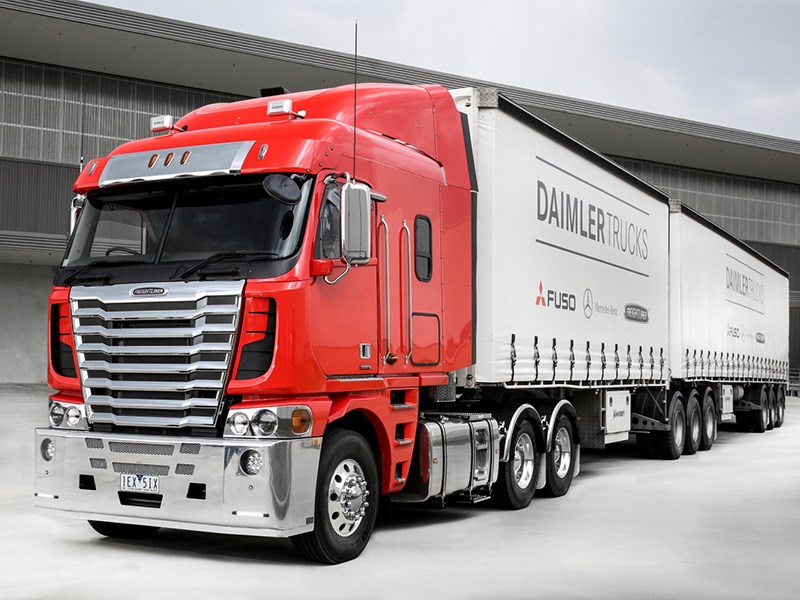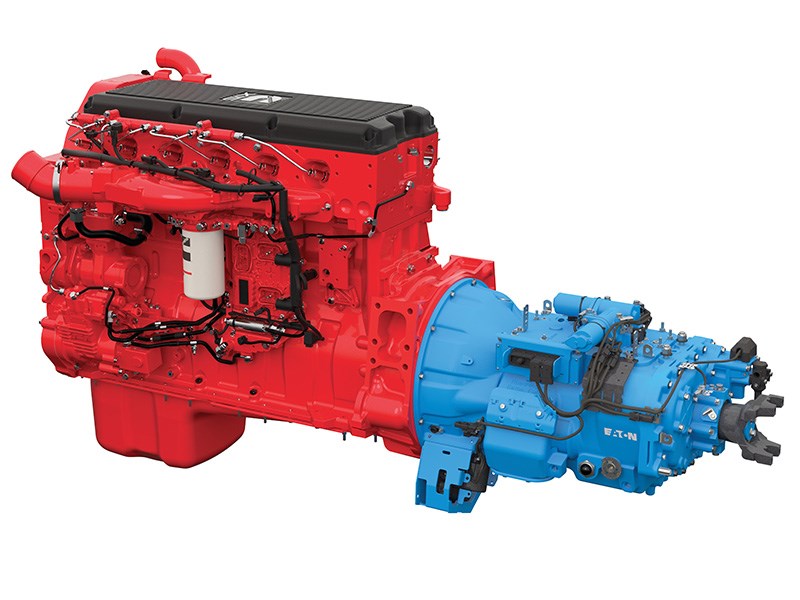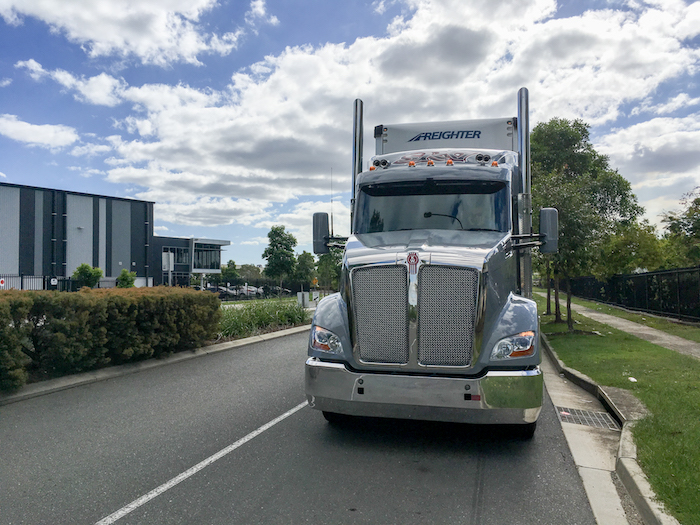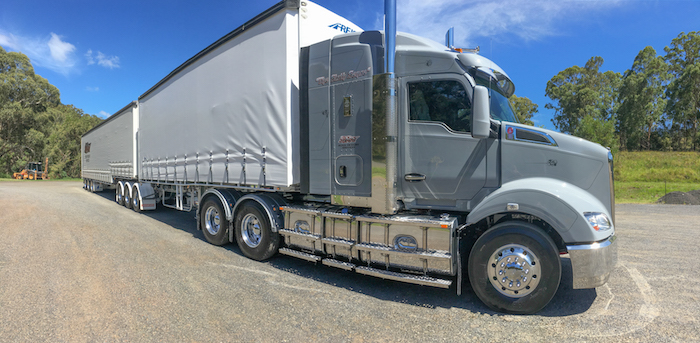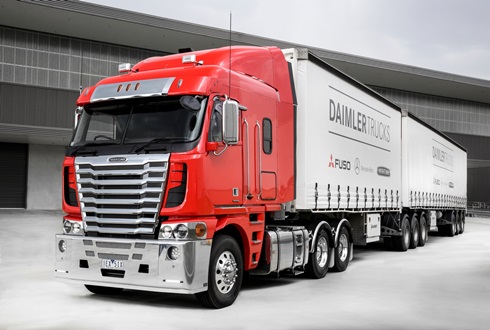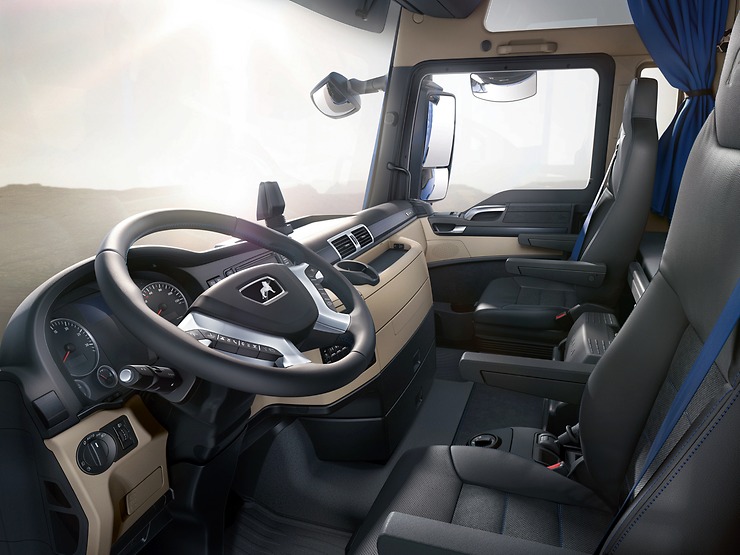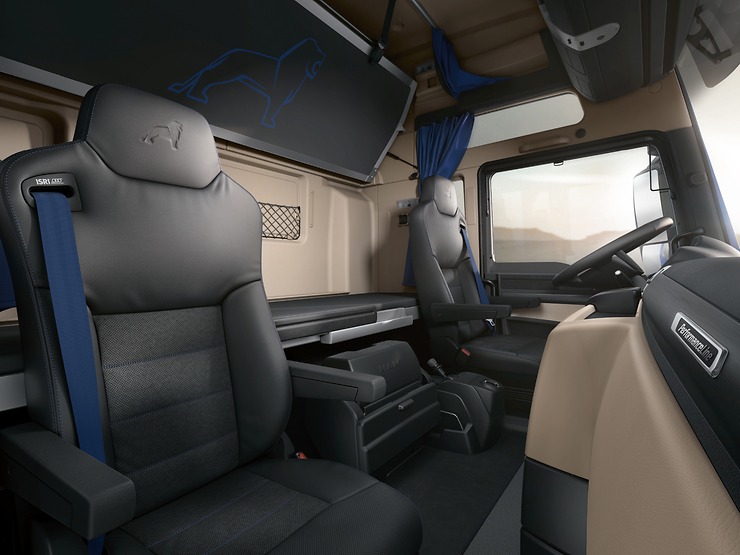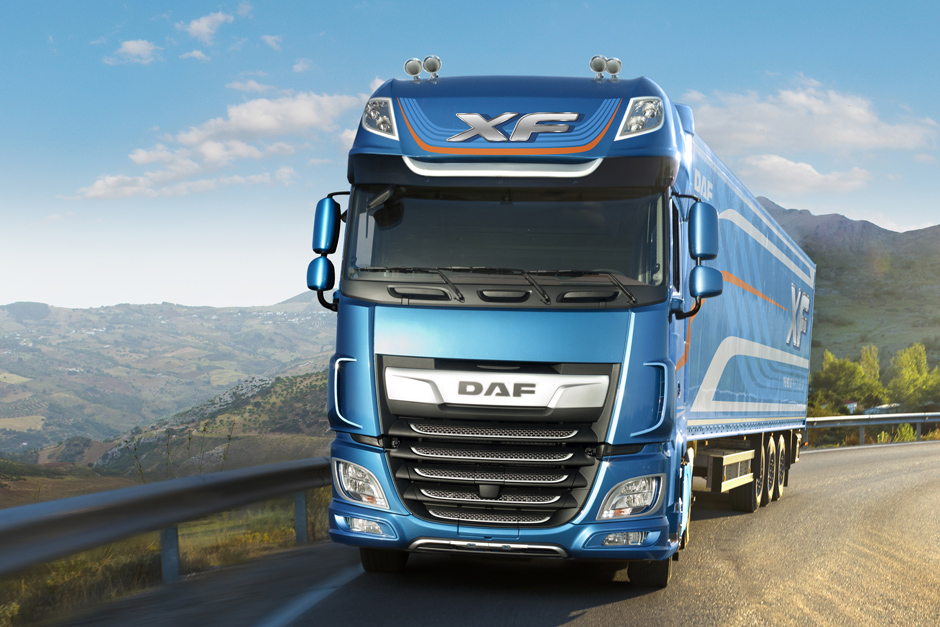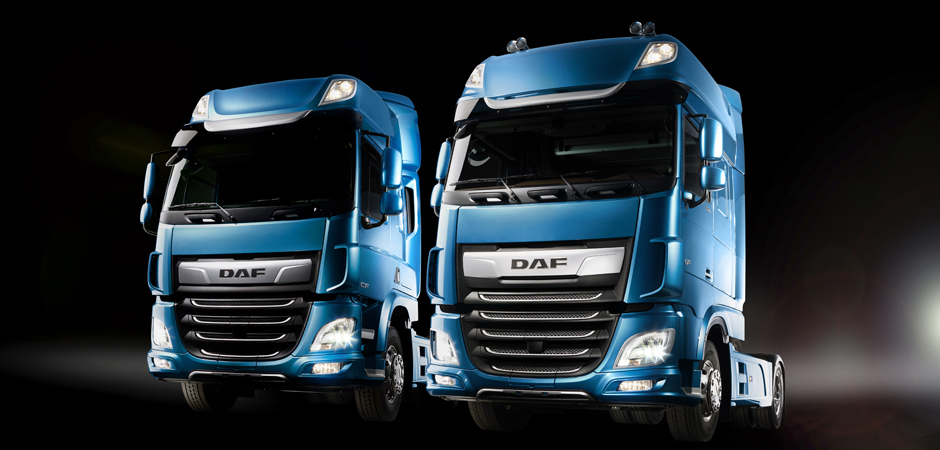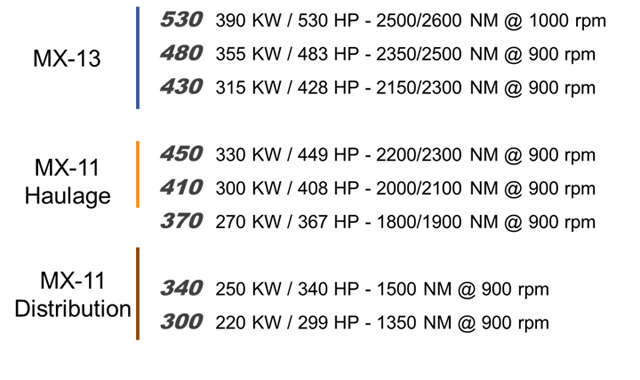
kscarbel2
Moderator-
Posts
17,893 -
Joined
-
Days Won
86
Content Type
Profiles
Forums
Gallery
Events
Blogs
BMT Wiki
Collections
Store
Everything posted by kscarbel2
-
What's atrocious about the swing-out step Billy? It works great for me. .
-
Iveco Trucks Australia Press Release / April 20, 2017 Iveco’s International Truck of the Year-winning Euro6 Eurocargo is now available in Australia, providing operators with a host of new safety and efficiency features rarely seen before in medium duty trucks. The models come in a variety of specification choices ranging from 12 to 18t GVM in 4x2 configuration and with ‘Day’, ‘Sleeper’ (with high roof option) and ‘Crew Cab’ variants, ensuring there’ll likely be a Eurocargo to suite a broad range of applications. Previous Eurocargo models have enjoyed a reputation for striking an excellent balance between power output and fuel efficiency, and the latest trucks take this combination to the next level. Efficient new ‘Tector 7’ engine Powering the range is Iveco’s new 6-cylinder, 6.7 litre ‘Tector 7’ engine. This advanced diesel power plant features high pressure, common rail, electronic injection, turbocharging and 24 valves. Available in two power ratings, the Tector 7 develops 250 hp (185 kW) and 627 lb/ft (850 Nm) in ML120 models, and 280 hp (206 kW) and 738 lb/ft (1,000 Nm) in ML 160 and ML180 models – all figures come at low rpm for improved response added fuel efficiency. To meet stringent Euro6 emissions standards (well before mandated in Australia), models use Iveco’s innovative new ‘HI-SCR’ system, a single after-treatment system featuring passive DPF (Diesel Particulate Filter). Coupled to the engines are a choice of either a manual ZF 9-speed overdrive transmission with dash-mounted gear shift or the Allison S3000, 5-speed full automatic which provides a more relaxed drive particularly in congested metropolitan conditions. Safety stakes raised The E6 Eurocargo raises the safety benchmark in the medium duty truck market with a range of innovative safety features not normally seen in this segment, especially amongst its Japanese competitors. All new Eurocargo variants feature the superior stopping power of front and rear disc brakes with ABS. New models also benefit from Anti-Slip Regulator (ASR), Electronic Stability Program (ESP) and Advanced Emergency Braking System (AEBS). The new Eurocargo can be specified with Adaptive Cruise Control (ACC) and a Lane Departure Warning System (LDWS) that warns the driver if the vehicle is moving from its lane. Rounding out the safety appointments is a Hill Holder function, Driver’s SRS airbag and Daytime Running Lamps (DRLs). Comfortable cabin Drivers can spend many hours behind the wheel each day so it’s important that a modern truck cabin is designed with ergonomics and comfort in mind to minimise fatigue. Cabin entry and egress in the new range is easy courtesy of generous steps and 90°-opening front doors. Once inside, the driver is treated to a fully adjustable ISRI seat and redesigned interior with all controls being placed initiatively within arm’s reach. A linear dashboard design (featuring electronic anti-glare instrument panel) and the compact dimensions of the engine tunnel, allow the driver to easily move around the cabin and leave the vehicle from either side in preparation for loading and unloading their goods. Iveco has also included a number of functional features in the cabin, allowing operators to more easily keep up with paperwork and other job requirements. The centre console has a 20 litre space (available with single passenger seat) that can comfortably accommodate a laptop, tablet and the like. It also features a reading light and is equipped with side storage pockets and two USB connectors for charging electronic devices. A practical workspace can also be created by opening out the upper area of the console. Other cabin appointments include a driver’s side console housing two bottle holders, a 12V power socket and option for a compressed air pocket. Additionally, there are more storage spaces throughout the cabin and a hanging rail with hooks on the rear wall of the cabin for items such as personal protection equipment and other apparel. For fleets wanting to run telematics, the new Eurocargo features the necessary hardware for easy integration of third party systems, allowing operators the versatility to choose the system best suited to their requirements. The Eurocargo models ride on a combination of front parabolic spring suspension with rear 2-Airbag Electronically-controlled Air Suspension (ECAS) for the ML120 and front parabolic spring suspension with rear 4-Airbag ECAS for ML160 and ML180 models. For superior handling, front stabiliser bars are standard on all models. The E6 Eurocargo will be sold alongside the earlier E5 models, providing operators with an even broader Eurocargo model choice. These earlier E5 vehicles (including 4x4) will also undergo enhancements in the coming months when they adopt their E6 sibling’s new exterior cabin appearance and many of the new model’s interior cabin appointments. Comments from Iveco ANZ Product Manager, Marco Quaranta Mr Quaranta said the new E6 Eurocargo is an important vehicle, not only for Iveco but for the broader industry. “Medium duty trucks are often seen as the ‘workhorses’ of urban and short haul intra-city delivery, and as such, they can be quite basic and Spartan in terms of specification levels with buyers often forgoing comfort and safety equipment,” Mr Quaranta said. “Gradually customer requirements are changing, being driven by a desire to not only have a truck that does the job, but one that does so more comfortably and more safely for the driver, while returning greater efficiency to the operator through reduced fuel consumption and lower whole of life costings. “The new E6 Eurocargo recognises that all operators are deserving of the latest vehicle technologies – these shouldn’t be reserved for those who operate a top-of-the-line European prime mover. “With clear back of cab options and up to 14 pallets of payload (day cab), Iveco is targeting customer across a range of applications from general freight and refrigerated, to tilt tray and crane truck work. “The Eurocargo is one of the best-selling medium duty trucks in Europe and growing in acceptance locally amongst operators who prefer higher safety, performance, comfort and sophistication levels - the latest release takes all of these benefits to new heights.” .
-
Brighter days for DAF in Australia Trade Trucks AU / April 25, 2017 Paccar is officially launching its new DAF 510hp CF85 model at the 2017 Brisbane Truck Show The anticipated introduction of a 510 horsepower version of DAF’s versatile CF85 model has the potential to create an entirely new era for the brand, according to DAF Trucks Australia general manager, Rob Griffin. The 510hp CF85 will be officially launched at the upcoming Brisbane Truck Show. DAF’s sales figures for the first quarter of 2017 were notably improved over previous years and the imminent introduction of the uprated CF85 is expected to provide significant impetus to plans for substantial growth of Paccar’s continental cab-over. Yet despite its established position as one of Europe’s most powerful players and arguably Paccar’s greatest success story, Rob Griffin concedes DAF has long struggled for recognition on the Australian market. Formerly national sales manager at Kenworth, he says there are many factors behind DAF’s modest acceptance by Australian truck operators, including a reputation forged long before Kenworth and Peterbilt parent Paccar took control of the Dutch truck and engine maker. "No doubt about it, the brand got off to an ordinary start in this country," he says, recalling pre-Paccar days when DAF’s Dutch principals largely took the Australian market for granted. "They were putting the truck into applications that just weren’t right for it, and they brought it here without any real testing, obviously thinking it could do anything other trucks were doing. "It wasn’t a bad truck," Rob Griffin insists. "In most cases it was just badly applied." DAF first came to Australia in 1984 when the brand was still a Dutch company. After a poor experience, the Dutch ultimately took their truck home. Then in 1996 Paccar paid US$540 million for the beleaguered brand and followed that in 1998 by taking control of Leyland operations in the UK where all right-hand-drive DAF trucks are now made. Despite the sceptics – and there were plenty of them – the acquisitions were an inspired move by Paccar. Applying its renowned management skills and economic acumen, Paccar turned the otherwise defeated DAF into a European powerhouse where it is today market leader in a number of countries including the highly competitive UK market. Last year alone DAF registered almost 47,000 trucks in Europe. Critically, it’s also a brand with a solid reputation for fuel efficiency from its own MX11 and MX13 engines, endorsing again the long-term reasoning behind Paccar’s decision to buy a truck brand that made its own engines. At the end of last year there were more than 135,000 MX engines powering Kenworth and Peterbilt models across the length and breadth of North America. Declaring a firm faith in DAF’s prospects for a stronger place on the Australian market, Rob Griffin asserts that much of the brand’s reputation and sales mediocrity in this country are based on aged perceptions rather than modern realities. "We’ve done a lot of work behind the scenes and the way DAF was in the past, belongs to the past," he comments. As for the suggestion that DAF in this country is often viewed as a poor cousin to big brother Kenworth, Rob doesn’t mince his words. "That’s how some others may see it, but they’re wrong. "We take the Kenworth association as a bonus. We’re setting up this business to complement what Kenworth brings to the market, not to take anything away from either brand. "The simple truth is that there are some applications best suited to a European cab-over and that’s where we’re aiming with DAF. "In fact, when you bring something new into the product range like this CF85 with an MX13 engine at 510hp, it creates an entirely new focus for the brand and opens us up to sections of the market we haven’t had before. "It will be enormous for us," he contends, "particularly with fleets. Price-wise it will be very competitive." Rob says the new model will be a spearhead in DAF’s re-emergence. "The 510 horsepower CF is a really important truck to our growth," he emphasises. "As it stands at the moment, the CF at its 460 horsepower rating is DAF’s best seller but for local and regional B-doubles, the industry has a psyche around 500 horsepower and that’s where the 510 rating under the CF cab opens up new market segments to DAF." However, the 510hp CF85 will not be aimed at linehaul work, Rob remarks. "The CF 510 is our suburban and intrastate model for either single trailers or B-doubles up to 70 tonnes. "We’ve specced it that way," he continues, "with a 16-speed automated (ZF AS-Tronic) transmission for the flexibility to flow with suburban traffic and provide the right balance between performance and fuel." The 510hp CF85 will be offered in 4x2, 6x4 and 8x4 configurations, and a confident Rob Griffin cites fuel economy, tare weight, cab entry and exit, vision and manoeuvrability as inherent assets of the model. "This truck will definitely surprise people but it’ll be critical to get people into it, to drive it and assess the truck on merit rather than mindset," he emphasises. "We have very few problems with our trucks in the field and we’re in no doubt the product is the best it has ever been. "We have all the right systems and packages in place so now we just have to keep getting people behind the wheel. "The truck will do the rest," a confident Rob Griffin concludes. .
-
New Cummins X15 available for Freightliner Argosy Trade Trucks AU / April 21, 2017 It is available in output ratings ranging from 485hp to 600hp and up to 2050lb-ft The new Cummins X15 engine is now available with Freightliner Argosy models. It is available in output ratings ranging from 485hp to 600hp and up to 2050lb-ft. An upgrade of the 15-litre ISXe5, the new X15 features Advanced Dynamic Efficient Powertrain Technology (ADEPT) – a suite of advanced electronic features capable of delivering fuel economy through improved powertrain integration. Tested in Australia since last year, ADEPT is for use with Eaton’s 18-speed automated UltraShift Plus transmission. It uses load, speed and grade-sensing technology to initiate adjustments to engine power, torque and transmission gear selection to take advantage of vehicle momentum for better fuel economy. The ADEPT package includes two features: SmartCoast – operates when the vehicle is on a moderate downhill grade by disengaging the front box of the transmission and returning the engine to idle to reduce drag, maintain momentum, and ultimately improve fuel economy. Once the engine commands the transmission to be put back in gear, the appropriate gear is engaged. SmartTorque – uses torque management intelligence to help eliminate unnecessary downshifts and keep the engine operating in the most fuel efficient ‘sweet spot’. Torque is varied across all gears depending on torque requirement. The release is timed with the availability of Cummins Connected Diagnostics – a telematics system that automatically processes fault code data, sending instant notifications from Cummins detailing probable root cause and providing recommended actions. There are plans to add Over-the-Air (OTA) engine programming and customisation to the engine in the near future to allow reprogramming or recalibration of the engine without having to take the truck to a service station. The new X15 engine is also available with the Detroit DD15. Freightliner says it is the only truck manufacturer to offer customers a choice of 15-litre engines for a heavy hauling B-double truck. .
-
Kenworth Balancing Act Diesel News AU / April 20, 2017 Moving with the times while keeping its traditional enthusiasts has created a Kenworth balancing act, where it retains a pragmatic quality. The brochure for the new trucks from Kenworth, the T610 and T610 SAR are headlined, ‘Our Best Truck Yet’ in its brochures. Of course, this can be dismissed as just a load of hype from the marketing department, but it is not like the Paccar organisation to go over the top on these occasions. Kenworth does have a lot to crow about, it is the dominant player in the Australian heavy duty market, and has been for some time. It is also coming under pressure from a couple of directions, the European cabover trucks are making inroads into heavy duty prime mover market and the older designs for conventional trucks are getting into dimensional strife in some applications. Often in Diesel News we talk about the debate between cabover and conventional and European vs US, but there are a large number of issues making truck buying choices trickier each year. However, the first question anyone considering these new trucks asks may not be about the exact dimensions, ratings and design. They are more likely to be more about whether these new trucks really do look and feel like a Kenworth, and carry on the long tradition so proudly developed by the Bayswater-based truck maker. Yes, they understand the compromises which have to be made by a boutique, in global terms, truck manufacturer. The days of individual trucks hand crafted for each individual have passed, now it’s all about streamlined tailored production of a truck capable of doing the job in the harsh Australian trucking environment. It is here where Kenworth has to do a tricky balancing act. The truck has to meet a number of conflicting expectations. There has always been a kind of ruggedness to a big KW, but the driver always notices the quality of the finish. The door closes precisely every time for ten years, cables don’t rub when running on farm tracks and those annoying little rattles in the cab are rare. This is the perception the company has been building up throughout its history. This brings us back to the question. Does it look and feel like a ‘proper’ Kenworth? The answer is, of course, yes. The compromises made in the design to bring the conventional Kenworth up to 21st century standard do not compromise those little cues which tell the driver they are in a KW. .
-
Prime Mover Magazine / April 24, 2017 Freightliner has increased the engine options for its Argosy prime mover by offering the new Cummins X15 engine in addition to the Detroit DD15. According to Freightliner, it is the only truck manufacturer to offer customers a choice of 15-litre engines for a B-double truck. The new X15 engine fitted to the Argosy is available in output ratings ranging from 485hp to 600hp and up to 2050lb-ft. “We are excited to be able to offer the new Cummins X15 to our loyal Argosy customers in addition to the proven Detroit DD15,” said Freightliner Director, Stephen Downes. “Freightliner is the only brand that can give customers at the heavy end of the market the opportunity to choose the big bore engine solution that best suits their application." The Cummins X15 is a development of the 15-litre ISXe5, which features Advanced Dynamic Efficient Powertrain Technology (ADEPT) – a suite of advanced electronic features the company says is capable of delivering fuel economy gains through improved powertrain integration. Freightliner says the ADEPT suite is for use with Eaton’s 18-speed automated UltraShift Plus transmission and has been tested in Australia since early 2016. The ADEPT package's SmartCoast feature operates when the vehicle is on a moderate downhill grade by disengaging the front box of the transmission and returning the engine to idle to reduce drag, maintain momentum, and ultimately improve fuel economy. Once the engine commands the transmission to be put back in gear, the appropriate gear is engaged. Meanwhile, its SmartTorque feature uses torque management intelligence to help eliminate unnecessary downshifts and keep the engine operating in the most fuel efficient ‘sweet spot’. Torque is varied across all gears depending on torque requirement. .
-
Volvo Group First-Quarter Earnings, Sales Rise
kscarbel2 replied to kscarbel2's topic in Trucking News
Unstable numbers from Volvo Göteborgs-Posten / April 25, 2017 Economics, it goes awry for AB Volvo. Now the pace is turned up in the factories in Tuve, as well as Vara and Skövde. "Now we can be happy for a few days - then we have to concentrate on getting even better. Competition is tough”, says CEO Martin Lundstedt. AB Volvo reported a pre-tax profit of SEK 6.4 billion for the first quarter of the year. A substantial increase compared to the profit of 5.3 billion kronor in the same period last year. As a result, the truck manufacturer also hit the expectations of the collective analysts - on average, they had a profit of approximately SEK 5 billion, according to Reuters compilation. The stock market was impressed and Volvo's B shares rushed around seven percent on Tuesday morning. "We have had a strong quarter, both in terms of profit and sales. The report shows many good examples of what we want to achieve in the organization - service sales increase, it is stronger for construction machinery and the truck market is also going strong. There is much to be enjoyed, but there is also much more we can do with the organization, "said Martin Lundstedt, President and CEO of Volvo. Five-fold profit for Volvo CE The biggest surprise is Volvo CE. The segment, which manufactures construction machinery, has long been hard pressed, seen as a problem child, and surrounded by stubborn sales sprawling. Sales now increase by 30 percent while it adjusted operating profit almost fivefold - to 1.6 billion from SEK 341 million in the same period last year. "We are in the midst of implementing a major improvement plan for Volvo CE - it brings results now. For example, internal efficiency and service sales have increased. At the same time, the market situation has improved in both Europe and Asia and also Africa and Oceania, "said Martin Lundstedt. Truck sales increased by more modest three percent during the period. The trend is the same as in the last year - sales in Europe are increasing while deliveries in North America are shrinking. Now, however, development can be broken. In the last three months, order intake in North America has increased by 27 percent. Martin Lundstedt, however, is cautiously optimistic. Europe backs "It is important to remember that we are now comparing with previous weak quarters. Even though order intake is increasing and inventory levels appear more normal for both new and used trucks, deliveries in North America decreased by 34 percent during the quarter. But the market has probably bottomed down now, he says. However, in the European market, to which the Tuve factory delivers, orders received decreased by one percent in total. Demand for heavy and medium-heavy trucks continues to be strong, while order bookings for light trucks fall by 37 percent. Volvo explains that many European customers "pre-purchased" light trucks in the first quarter of last year before the EU introduced new, stricter emission regulations. The truck manufacturer, however, retains its previous forecasts for both the European market and North America - while increasing for China. Now it is expected that a total of 765,000 heavy trucks will be sold in China during the year - 110,000 more than Volvo previously believed. The threat - political concern Overall, it is now better for all Volvo's operations. The Group sells both more buses and boat engines while increasing profitability for the four different business areas significantly. The factories are under pressure and production, and the number of employees, has increased in both the Tuve factory and the engine plants in Vara and Skövde. As the GP told us earlier this week, Volvo will also employ 500 new engineers. What threatens the positive trend? Martin Lundstedt points out the increased political unrest in the world, like a worrying cloud. "There is a greater measure of insecurity today, including in the relationship between different continents. We are affected by how the economy is developing globally and of possible threats to, for example, free trade. Therefore, we must maintain flexibility in the organization and ensure that we have country organizations that can handle development, he says. -
Volvo Trucks Press Release / April 21, 2017 Arclid Transport believes that the key to a successful business is getting the best out of both its drivers and its trucks. By investing in Volvo Trucks’ lightweight pusher axle, combined with driver training, fleet manager Peter Conway successfully achieved his goal of maximizing payload and increasing productivity. .
-
Scania Financial Services - customer testimonials
kscarbel2 replied to kscarbel2's topic in Trucking News
-
MAN Trucknology Days 2017: Connected Performance
kscarbel2 replied to kscarbel2's topic in Trucking News
-
The 640hp MAN TGX - First PerformanceLine edition goes to BFS
kscarbel2 replied to kscarbel2's topic in Trucking News
First MAN TGX PerformanceLine edition delivered – No 001 for BFS/Stegmaier Group MAN Truck & Bus Press Release / April 24, 2017 Flagship of the MAN TGX series with 640 hp presented for the first time at the IAA | BFS (Business Fleet Services), Stegmaier Group’s hire division, receives No 001 of the special edition | MAN PerformanceLine edition brings together numerous special features in the cab and in the exterior design, creating an exclusive premium vehicle The flagship of the MAN TGX series with 640 hp was presented at the IAA as a special edition limited to 100 vehicles. Heinz-Jürgen Löw, Sales & Marketing Director at MAN Truck & Bus AG, has now personally handed over the key to No 001 of the special edition to BFS (Business Fleet Services), Stegmaier Group’s hire division, at MAN Truck Forum. The MAN PerformanceLine edition brings together numerous special features in the cab and in the exterior design, creating an exclusive premium vehicle. It is exclusively available as part of the MAN TGX series with the Euro 6-compatible high-end motorisation of 640 HP. In terms of the exterior view, the mirror covers and lower radiator grille screen are anthracite-coloured. Features include chrome applications on both horizontal radiator slats, a sun visor and two compressed-air horns. The PerformanceLine lettering on the doors denotes the special model. The interior of the TGX is like a gem. There are blue applications in many places: Blue contrast stitching accentuates the shape of the multifunctional leather steering wheel, the high-comfort seats and the floor covering. The lion motif is embossed on the headrest and is clearly visible as a blue outline on the lower covering of the upper bed. Also coloured blue are the seatbelts and the inward-facing side of the all-around curtains. The dark blue brushed aluminium inlays are always in view on the dashboard. An additional PerformanceLine plaque on the passenger-side dashboard alludes to the special series’ exclusivity. The PerformanceLine lettering also appears on the display when the MAN Media Truck Advanced radio and navigation system is turned on. This stands out thanks to its outstanding sound system and numerous additional functions, such as standard digital radio reception. Exclusivity and comfort are provided by the leather interior trim and seat covers in a mix of Alcantara and leather. BFS received the MAN TGX PerformanceLine edition in the form of a two-axle semitrailer painted in metallic steel blue with a styling package. This consists of highly-polished stainless steel front and side bars with integrated LED accent lighting, as well as a huge light bar with four halogen high-beam headlights. Hermann Stegmaier, Director of the Stegmaier Group, expressed his delight on the occasion of the key handover: “We are pleased to be able to accept the first PerformanceLine edition. Our aspiration is to always have the most powerful vehicles in our rental vehicle fleet and to inspire our customers. This truck, which I also personally like very much, fits this perfectly. It is the 3000th MAN that we have acquired for BFS in our company’s history and at the same time, it’s also our edition for Stegmaier Group’s 90th anniversary.” . -
Paccar Achieves Good First Quarter Revenues and Profits DAF Trucks Press Release / April 25, 2017 “PACCAR reported good revenues and net income for the first quarter of 2017,” said Ron Armstrong, chief executive officer. “PACCAR benefited from increasing truck production in North America and Europe, as well as record quarterly PACCAR Parts pretax profits. I am very proud of our 23,000 employees who have delivered industry leading products and services to our customers.” First quarter 2017 net sales and financial services revenues were $4.24 billion compared to $4.30 billion for the first quarter of 2016. PACCAR earned net income of $310.3 million ($.88 per diluted share) in the first quarter of this year compared to a net loss of $594.6 million ($1.69 per diluted share) in the same period last year. PACCAR earned adjusted net income (non-GAAP)1 of $348.0 million ($.99 per diluted share) in the first quarter of 2016, excluding a $942.6 million non-recurring charge for a European Commission (EC) settlement. Ron Armstrong added, “PACCAR’s strong balance sheet and positive operating cash flow, which has averaged $2.3 billion per year in the last five years, have enabled the company to invest $3.1 billion in new facilities, products and services during the same period. New Kenworth, Peterbilt and DAF vehicles, an expanded PACCAR engine range, innovative PACCAR Parts aftermarket programs, advanced driver assistance systems (ADAS), and PACCAR Financial Services mobile applications are contributing to the company’s long-term growth.” Highlights – First Quarter 2017 Highlights of PACCAR’s financial results during the first quarter of 2017 include: Consolidated net sales and revenues of $4.24 billion. Net income of $310.3 million. Truck, Parts and Other gross margin of 14.1%. PACCAR Parts revenues of $786.7 million and record pretax profits of $151.7 million. Cash generated from operations of $610.5 million. Research and development expenses of $61.0 million. Manufacturing cash and marketable securities of $2.89 billion. Stockholders’ equity of $7.08 billion. Global Truck Markets DAF’s above 16-tonne truck orders increased 12 percent in the first quarter of 2017 compared to the same period last year. “Our customers recognize DAF’s excellent product quality, low operating costs and strong resale value,” said Preston Feight, DAF president and PACCAR vice president. “We’ve increased our estimate of 2017 European truck industry registrations in the above 16-tonne truck segment to a range of 270,000-300,000 vehicles.” DAF recently introduced their new 2017 XF and CF trucks at the Commercial Vehicle Show in Birmingham, U.K. These excellent new vehicles incorporate advanced aerodynamics, enhanced powertrain performance and lightweight materials to provide customers with up to seven percent greater fuel efficiency. Sophisticated computational fluid dynamics tools were used to optimize the new trucks’ aerodynamic performance. The PACCAR MX-13 and MX-11 engines have higher efficiency combustion, turbocharging and aftertreatment systems that are electronically integrated with the new automated 12 speed transmission to optimize performance at lower engine speeds. The PACCAR MX-13 engine offers new power ratings that provide up to 530-hp and 1,900 lb-ft of torque. “U.S. and Canada Class 8 truck industry orders were 40 percent higher in the first quarter of 2017 compared to the same period last year,” said Darrin Siver, PACCAR senior vice president. “The truck market reflects the good economy and steady freight demand. Peterbilt and Kenworth achieved 32 percent share of U.S. and Canada Class 8 truck industry orders in the first quarter this year. Class 8 truck industry retail sales for the U.S. and Canada in 2017 are expected to be in a range of 190,000-220,000 vehicles. Peterbilt and Kenworth Launch Updated Vocational Trucks Kenworth and Peterbilt recently introduced set-forward front axle (SFFA) vocational models. The durable and reliable Kenworth T880S and the Peterbilt Model 567 SFFA trucks are designed to optimize weight distribution and maximize payload in construction, concrete mixer and other applications supporting infrastructure investments. The Kenworth T880S and Peterbilt Model 567 are powered by the PACCAR MX-13 engine with up to 510-hp and 1,850 lb-ft of torque, or the PACCAR MX-11 engine providing up to 430-hp and 1,650 lb-ft of torque. “Kenworth and Peterbilt have an excellent history of leading the vocational truck segment. The new Kenworth T880S and Peterbilt Model 567 enhance this legacy and provide customers with a breadth of configurations designed for their specific applications,” said Gary Moore, PACCAR executive vice president. Peterbilt, Kenworth and DAF Dealers Invest in Global Growth Peterbilt, Kenworth and DAF dealers have invested over $1 billion and have added nearly 200 locations during the last five years to enhance customer service in North America and Europe. “PACCAR MX engines have increased the aftermarket business opportunity for PACCAR dealers,” noted Harrie Schippers, PACCAR executive vice president and chief financial officer. “The network expansion delivers industry-leading service, enhanced parts availability and excellent operating efficiency for Peterbilt, Kenworth and DAF customers. These investments support PACCAR’s truck and parts market share growth.” PACCAR Parts Achieves Record Profitability PACCAR Parts’ 17 parts distribution centers support over 2,100 DAF, Kenworth and Peterbilt dealer service locations. PACCAR Parts achieved record quarterly pretax income of $151.7 million in the first quarter of 2017, which was 13 percent higher than the $134.6 million earned in the same period last year. PACCAR Parts generated revenues of $786.7 million in the first quarter of 2017, nine percent higher than the $719.5 million reported in the same period last year. “PACCAR Parts has achieved eight percent average annual sales growth over the last 15 years. This superb performance has been driven by ongoing investments in PACCAR Parts and dealer facilities, expanded PACCAR-branded and TRP product lines, and an increased number of PACCAR trucks and engines in operation,” said David Danforth, PACCAR Parts general manager and PACCAR vice president. Financial Services Companies Achieve Good Results PACCAR Financial Services (PFS) has a portfolio of 178,000 trucks and trailers, with total assets of $12.27 billion. PACCAR Leasing, a major full-service truck leasing company in North America and Europe with a fleet of 37,000 vehicles, is included in this segment. PFS’ first quarter 2017 pretax income was $57.3 million compared to $80.3 million earned in the first quarter of 2016. PFS achieved first quarter 2017 revenues of $302.2 million compared to $289.4 million in 2016. “PFS’ portfolio performed well during the first quarter of 2017.” said Bob Bengston, PACCAR senior vice president. “The industry’s lower used truck values in the U.S. and Canada impacted PFS’ quarterly results. Used truck demand is increasing and prices have stabilized.” PACCAR’s strong balance sheet, complemented by its A+/A1 credit ratings, enables PFS to offer competitive retail financing to Kenworth, Peterbilt and DAF dealers and customers in 24 countries on four continents. PACCAR Financial Corp. (PFC) recently opened a new truck remarketing center in Minooka, Illinois, near Chicago. The new facility complements PFC’s truck remarketing centers in Salt Lake City, Utah and Spartanburg, South Carolina. “Kenworth and Peterbilt pre-owned trucks sell at a premium price compared to similar competitor models,” Todd Hubbard, PFC president, commented. “Our portfolio of Kenworth and Peterbilt trucks reflects the popularity of PFC’s excellent truck leasing and financial products.” Capital Investments and Research and Development PACCAR’s excellent long-term profits, strong balance sheet, and intense focus on quality, technology and productivity have enabled the company to invest $6.2 billion in world-class facilities, innovative products and new technologies during the past decade. “In 2017, capital expenditures of $375-$425 million and research and development expenses of $250-$280 million are targeted for truck and powertrain product development, enhanced manufacturing facilities and aftermarket support programs,” commented George West, PACCAR vice president. Peterbilt Motors recently completed construction of a 102,000 square-foot expansion to its truck manufacturing facility in Denton, Texas. “The new, state-of-the-art test and logistics center will streamline vehicle delivery and enhance manufacturing efficiency and capacity,” said Kyle Quinn, Peterbilt general manager and PACCAR senior vice president. “Peterbilt plans to install additional robotic cab assembly equipment to increase production capacity of its industry-leading Model 579 and Model 567 trucks.” .
-
DAF reveals the new DAF CF and XF - Pure Excellence
kscarbel2 replied to kscarbel2's topic in Trucking News
The new DAF CF and XF - Pure Excellence DAF Trucks Press Release / April 25, 2017 DAF is introducing the new generation CF and XF trucks, which set a new standard in transport efficiency and driver comfort. Engine innovations, new drivelines and aerodynamic optimizations result in an up to 7% lower fuel consumption. The new DAF Connect fleet management system will drive even larger efficiency gains. The new generation CF and XF also feature lower weight for increased payload and an updated interior and exterior design for the highest driver comfort and greatest appeal. These excellent new trucks provide our customers with the lowest operating cost and the highest uptime. “Building on the excellent reputation for fuel efficiency, reliability and driver comfort the current Euro 6 product range has earned in Europe, DAF has developed a new generation of CF and XF trucks offering the best possible solutions for both the customer and the driver”, shared Preston Feight, DAF Trucks president. “Backed by industry leading services and a highly professional dealer organization, the new CF and XF trucks - entering production in summer 2017- embody an owner’s delight and the driver’s dream.” The new CF and XF: Owner’s delight 7% lower fuel consumption - PACCAR MX-11 and MX-13 engine innovations - New efficient TraXon automated gearbox - New high efficiency rear axles with new faster ratios - Advanced powertrain software features - Aerodynamic optimizations New PACCAR Engine Brake Up to 100 kilogram higher payload - New compact Exhaust After-treatment System Maximum uptime - Service-intervals up to 200,000 km - First class body builder-friendliness DAF Connect fleet management system for the highest transport efficiency Improved fuel efficiency, along with more power and torque at lower revs. Class-leading fuel efficiency is the result of the fully integrated and innovative driveline that achieves optimum interaction between engine, after-treatment system, transmission and rear axles, for lowest total cost of ownership, fully aligned with the DAF Transport Efficiency philosophy. The air management of the PACCAR MX engines has been further improved by applying a new and even more efficient turbocharger, a new EGR system and a new valve actuation design. Thermal efficiency has been enhanced by developing a new combustion system, including new pistons, injectors and injection strategies, while higher compression ratios are employed. New highly efficient variable speed cooling-, steering- and oil pumps are used to achieve the lowest fuel consumption. A key principle when developing the new drivelines was to reduce engine revs for best-in-class fuel efficiency. Maximum torque of the PACCAR MX-11 and MX-13 engines has been increased significantly and is already available from 900 rpm to allow down speeding of the engine. The top-of-the range PACCAR MX-13 engine produces 390 kW/530 hp and 2,600 Nm of torque at 1,000 rpm. Highly-efficient rear axle designs Rear axle designs have been further developed and reductions of down to 2.05:1 can be specified for driving at cruising speeds of 85 km/h at only 1,000 – 1,040 rpm, depending on driveline choice. The new generation of rear axle differentials features a completely new design of crown wheel and pinion, aimed at highest durability and efficiency as well as extremely low noise levels. Application of low viscosity oils, lower oil levels in the rear axles and low friction wheel end bearings also enhance fuel efficiency. Efficient TraXon gearbox as standard The latest generation of TraXon automated gearboxes are standard on the new CF and XF series with the 12 speed being standard and a 16 speed optional. Less friction losses, even faster upshifts and the extended use of EcoRoll contribute to lowest fuel consumption. Driver comfort is enhanced thanks to its quiet and smooth operation and precise clutch control. The increased ratio spread allows excellent maneuverability, even when faster drivelines are applied. Advanced powertrain software features The new CF and XF feature a completely new electric and electronic architecture. It introduces a new vehicle control unit for dedicated driveline integration, featuring enhanced EcoRoll and Cruise Control functionalities, such as Dynamic Cruise. Dynamic Cruise adapts the character of the cruise control to the different driving circumstances. Thanks to a further integration of Predictive Cruise Control (PCC) and EcoRoll, PCC can now activate EcoRoll sooner, when both technologies have calculated that vehicle momentum is sufficient to carry the vehicle in neutral gear over the top of the hill within a set speed bandwidth. Industry-leading PACCAR Engine Brake performance Next to engine performance, the performance of the PACCAR Engine Brake has been enhanced. Maximum braking power of the PACCAR MX-11 engine has grown from 320 to 340 kW. Braking power has increased 20% between 1,000 to 1,500 rpm. Maximum braking power of the MX-13 is no less than 360 kW and in the important 1,200 to 1,500 rpm range, braking power has increased up to 30%. Aerodynamic Optimizations In order to achieve lowest possible fuel consumption, vehicle aerodynamics have been improved thanks to a new sun visor design for the CF and XF. In addition, the new XF features wheel bay extensions and flow guides behind the grille for optimal aerodynamics around the truck and through to the engine bay. New grille closures reduce drag, and new gap closures between the headlight and corner deflector realize the best possible aerodynamics. Up to 100 kilogram higher pay load For the new CF and XF, DAF has developed a completely new and compact Exhaust After-treatment System (EAS), which results in more chassis space for components such as larger fuel tank, compressors, tool boxes or crane legs. An advanced substrate technology allows for a 40% reduction in overall volume in the EAS unit. This is done without compromising backpressure, ash cleaning intervals or DeNOx efficiency. In fact, the compact box heats up faster allowing the engine to operate quicker and even more frequently in its most efficient fuel map. The compactness of the EAS units also means that for special applications, DeNOx catalytic converter and Diesel Particulate Filter don’t need to be split anymore, which contributes to excellent overall efficiency. Another advantage of the new ultra-compact EAS unit is that it is some 50 kilograms lighter. Thanks to additional measures like engine and chassis weight optimisation, the new CF and XF offer 100 kilogram more payload. Maximum uptime Service intervals of the new DAF CF and XF can be extended from 150,000 to 200,000 kilometer. Despite the compact dimensions of the new EAS unit, its capabilities are unmatched, resulting in ash cleaning intervals of up to 500,000 kilometer, which contributes to maximum customer uptime. The enhanced Body Attachment Method supports the shortest configuration time, as the new design at the rear end of the chassis allows easy fitment of, for instance, tail lifts and dedicated prepared installation plates for boxed bodies and cranes. DAF Connect fleet management system DAF Connect is an innovative fleet management system, offering the operator real-time information on the performance of his vehicles and drivers. Information on vehicle location, fuel consumption, mileage, fleet utilization and idle time are clearly presented in an on-line dashboard, which can be tailored to customer requirements. The user-friendly dashboard can be configured to provide comprehensive fuel reports with current and historical data that compares the fleet’s vehicles and drivers. The Live Fleet View feature provides all the information needed about the location of the fleet in order to enable optimal planning including distances, routes and driving time for the vehicle and driver. Operators receive self-defined alerts when deviations occur in areas like speed, route, location and fuel consumption so they can immediately improve fleet performance. DAF Connect optimizes vehicle availability, reduces operational cost and enhances logistical efficiency. DAF Connect also allows the transport operator to effectively plan repair & maintenance and take advantage of tailor-made advice by DAF when using DAF Connect. The new CF and XF: Drivers Dream The new CF and XF remain the industry leader in driver comfort, thanks to their great accessibility, excellent interior space and many innovations that enhance comfort, user-friendliness, attractiveness and safety. New interior trim New Temperature and Climate Control (HVAC) New Exclusive Line Upgraded instrument panel and dashboard lay-out Plug and play driver preference switches From the moment you step inside, the new DAF CF and XF deliver the highest level of quality and driver comfort. New warm and tasteful colors on the dashboard, seats, curtains, mattresses, side and back walls give the interior a beautiful appearance in which every driver can appreciate the luxury and richness. The XF piano black decoration on dashboard and rear wall gives the interior extra appeal. The XF Super Space Cab remains the most spacious cab on the market with a total volume of more than 12.6 m3. New temperature and climate control The new DAF CF and XF feature a completely new automatic HVAC system which is very easy to operate. The system also contributes to the best fuel efficiency as the new smart controlled air-conditioning system consumes less energy by cooling the air down only as much as is needed to reach the desired temperature. Intelligent control of the evaporator is also used to avoid unnecessary air cooling. The new fully automated HVAC system uses residual heat from the engine for heating the cab during shorts breaks, which adds to fuel efficiency. The new temperature and climate control systems can also be operated using the new rear wall panel with temperature display for highest driver comfort. New Exclusive Line The summit of luxury and comfort is the new Exclusive Line, available for both the new CF and XF. The top-of-the range Exclusive Line is distinguished by the cognac colored dashboard, door panels (XF) and leather seats, as well as the stylish bright vents (CF). A leather steering wheel is standard on the luxurious CF and XF versions. Enhanced Driver Information and user-friendliness The instrument panel has been redesigned with new characters for a more modern and attractive appearance and enhanced clarity. The enhanced Driver Information Panel includes a tachograph countdown, displaying remaining driving and resting times. This contributes to enhanced comfort and efficiency, as do the driver configurable switches (MUX), which allow the driver to position dashboard switches according to his/her preference. MUX-switches also allow optimal positioning of controls and switches for the operation of the superstructure or components like aggregates and crane leg supports. Drivers will also benefit from the new interior light switch, positioned in the central part of the dashboard, while DAF’s great sliding table and unmatched storage space remain untouched. The new interior light switch stands out in user-friendliness with possibilities of dimming for ‘night drive’ and ‘relax’ modes. All speed related functions, including cruise control, predictive cruise control and adaptive cruise control are perfectly and logically grouped at the right side of the steering wheel. Great looks DAF has enriched the exterior styling with subtle and stylish elements, like the identity plate in the doorstep which welcomes the driver to the luxurious interior (XF). A new DAF nameplate with a redesigned DAF logo featuring chrome letters symbolize the trucks’ quality. Accents in the bumper and sun visor give the exterior an extra touch of richness, as do the decorative strips in the grille and the new grill mesh for the XF. Start of Production The new CF and XF will enter production in the summer of 2017 in 4x2 tractor (FT) and rigid (FA) configurations, the 6x2 tractor FTG and FTP with pusher axles, and the 6x2 rigid with single mounted trailing axle (FAR). Other excellent versions will follow in autumn. “We have made the best trucks on the market even better”, commented Preston Feight, DAF Trucks president. “The new CF and XF further extend the current trucks excellent reliability, fuel efficiency and driver comfort. As part of our DAF Transport Efficiency philosophy we have again made major steps to further enhance vehicle efficiency by providing the lowest operating cost and the higher uptime for our customers. The new CF and XF represent Pure Excellence.” . . -
Paccar Revenue Dips in 1Q but Profits Return Transport Topics / April 25, 2017 First-quarter sales for Paccar Inc. dipped 1.9%, year-over-year, but the company returned to profitability as it did not have a large, one-time charge as it did in early 2016. The Bellevue, Wash.-based parent of Kenworth Trucks and Peterbilt Motors earned $310.3 million, or 88 cents a share, on revenue of $3.94 billion during the quarter just ended. A year earlier the company lost $594.6 million, or $1.69, on sales of $4.01 billion. The company’s three major segments — new trucks, part sales and financial services — all remained profitable. New truck deliveries dropped in the United States and Canada, and for the company as a whole, although they gained in Europe and the rest of the world. The year-ago charge for $942.6 million was a settlement paid to the European Commission regarding Paccar’s DAF Trucks unit based in the Netherlands. The charge reduced net income by $2.68 a share, the company said in its April 25 earnings report. “Paccar benefited from increasing truck production in North America and Europe, as well as record quarterly Paccar Parts pretax profits,” said CEO Ron Armstrong. The company maintained its January estimate for U.S. and Canadian Class 8 retail truck sales at 190,000 to 220,000 units, about the same as 216,000 vehicles in 2016. Among Paccar’s divisions, quarterly new truck sales dipped to $3.13 billion from $3.27 billion, while global operating profit for the division declined to $241.7 million from $304.1 million. If businesses weren’t buying as many trucks, they were at least buying parts for the equipment they kept. Sales rose to $786.7 million from $719.5 million, and profits to $151.7 million from $134.6 million. The company also has a financial services unit where revenue increased but profitability declined. By geography, quarterly truck deliveries outside the U.S. and Canada — mainly Europe — were 18,000 units, up from 16,800 in the 2016 period. For the U.S. and Canada, deliveries declined to 17,000 vehicles from 18,500. Despite the volume decline, the U.S. and Canada still produce a majority of quarterly sales, $2.52 billion, versus $1.72 billion from the rest of the world.
-
Jason Cannon, Commercial Carrier Journal (CCJ) / April 25. 2017 Paccar posted first quarter 2017 net sales and financial services revenues of $4.24 billion Tuesday morning, down slightly from the $4.3 billion during the first quarter of 2016. Net income jumped from a loss of $594.6 million last year to a surplus of $310.3 million in the quarter. “Paccar benefited from increasing truck production in North America and Europe, as well as record quarterly Paccar Parts pretax profits,” says Ron Armstrong, the company’s chief executive. U.S. and Canada Class 8 truck orders rose 40 percent in the first quarter of 2017 compared to the same period last year. “The truck market reflects the good economy and steady freight demand,” says Darrin Siver, Paccar senior vice president. “Peterbilt and Kenworth achieved 32 percent share of U.S. and Canada Class 8 truck industry orders in the first quarter this year.” Siver adds he expects Class 8 truck industry retail sales for the U.S. and Canada in 2017 in a range of 190,000-220,000 vehicles.
-
Volvo Group First-Quarter Earnings, Sales Rise
kscarbel2 replied to kscarbel2's topic in Trucking News
Volvo posts improved sales, Volvo & Mack gain marketshare Jason Cannon, Commercial Carrier Journal (CCJ) / April 25. 2017 Volvo Group posted improved sales and profitability for the first quarter Tuesday. Global volumes of heavy-duty and medium-duty trucks fell 4 percent, led by a North American market that Volvo Group President and CEO Martin Lundstedt says “seems to be bottoming out.” “We see positive signs of increased order activity,” he adds. Volvo Group’s net sales increased by 8 percent to $8.7 billion in the first quarter. Vehicle sales increased by 3 percent, primarily on good demand for products in Europe and Asia. North American heavy-duty truck industry orders increased during the quarter (from 8,892 to 11,334), and “dealer inventories of new trucks are at healthy levels,” Volvo said through its earnings release. “However, inventories for used long- haulage trucks remain elevated. This continues to dampen demand for new trucks in this segment despite indications of an improving freight environment. Demand in the refuse and construction segments remains good. Retail sales for the industry are forecasted to be lower 2017 compared to 2016.” In North America, deliveries were down 34 percent compared to the same quarter last year. Both Volvo Trucks and Mack gained market shares, with Volvo Trucks reaching 9.4 percent and Mack reaching 8.9 percent. “An order intake increase of 27 percent was driven by both Volvo Trucks and Mack activity within the construction segment and a somewhat improved freight environment combined with low dealer inventories,” the company says. Earlier this month, Volvo launched its new Volvo VNR regional haul tractor – the company’s first step in the renewal of the Volvo lineup in North America. “With its modern, ergonomic and more aerodynamic cab, the new vehicle will significantly improve Volvo’s position in the regional haul market,” Lundstedt says. “Product features are focused on delivering the maneuverability, productivity and safety that are so important to customers in this segment.” -
Transport Topics / April 25, 2017 Volvo AB posted first-quarter gains in earnings and profitability, most of which was generated by its construction equipment division, as the larger truck division was fairly static compared with the same time in 2016. While construction equipment profits surged 374%, in part due to a stronger global mining industry, the truck unit encountered a varied market. The Gothenburg, Sweden-based corporation said Asia is expanding in terms of truck sales, Europe is stable and North America still falling, although net orders for new North American trucks are rising. Corporate-wide, Volvo earned the equivalent of $539.9 million, or 26.1 cents a share, on global revenue of $8.67 billion. In the 2016 first quarter, the company had net income of $447.9 million, or 21.9 cents, on sales of $8.48 billion. At the global truck division, including North American brands Volvo and Mack, operating profit rose 31%, as measured in Swedish kronor, to the equivalent of $550.4 million from $442.2 million during the first three months of last year. Quarterly sales moved to $5.55 billion from $5.68 billion. The strengthening U.S. dollar turned the krona-denominated increase into a dollar decrease. Worldwide deliveries of new Volvo Group trucks dipped 5% for the quarter to 43,927 vehicles. Pricing improved, though, and the smaller number of vehicles sold turned into a revenue increase of 0.15%, year-over-year. The big source of quarterly improvement at the truck division came from maintenance, technology and other services, which rose by 11%. “After the downward correction in the long-haulage segment in 2016, the North American market seems to be bottoming out. We see positive signs of increased order activity,” Volvo CEO Martin Lundstedt said in the company’s April 25 report. He also mentioned the introduction of the company’s new North American regional-haul tractor. Quarterly deliveries fell most severely in North America, by 34%, to 7,065 from 10,740. The best geographies for the group’s truck deliveries were Asia, up 8% and Africa/Oceania, up 7%. Among net new-truck orders, four areas had year-over-year growth of 20% or more: Asia, up 31%; South America, up 29%; and Africa/Oceania, up 21%. North American growth was 27%, to 11,334 from 8,982 in the 2016 quarter. Bloomberg News reported that Volvo has canceled planned North American stop days, which will operate without the planned changes during the second quarter because of the stronger demand. The wire service said Lundstedt told this to stock analysts. Volvo Trucks North America spokesman Brandon Borgna offered confirmation. “We had originally planned to take some downtime at our New River Valley [Va.] assembly plant but have canceled those plans as a result of strengthened order support,” he said. A Mack spokesman was not immediately available for comment.
-
The Morning Call / April 25, 2017 Mack Trucks delivered a mixed load of numbers in its first quarter, dragged down by lower output totals but propelled forward by a surge in orders logged during the first three months of 2017. First, the bad: Mack delivered 3,925 trucks worldwide during the first quarter, a 24 percent decrease from 5,176 in the year-earlier period, according to a report released Tuesday by Mack's parent company, Sweden's Volvo Group. While deliveries declined as expected, both the Mack and Volvo truck brands experienced a sizable increase in net order intake in North America, driven by "higher activity within the construction segment and a somewhat improved freight environment combined with low dealer inventories," Volvo wrote in the report. Mack received 5,703 orders in North America during the first quarter, up 39 percent from 4,117 a year earlier. Meanwhile, Volvo received 5,596 orders in the quarter, up 19 percent from 4,687 in the year-earlier period. In addition, Volvo wrote in the report, Mack and Volvo both gained market share in North America during the quarter. The Volvo Trucks brand now has 9.4 percent of the North American market, while Mack reached 8.9 percent. Mack employs about 1,480 people at its Lehigh Valley Operations, which includes its 1-million-square-foot Lower Macungie Township facility, where all Mack trucks built for the North American market and export are assembled. While heavy-duty truck orders ticked up in North America, Volvo noted that dealer inventories for used long-haulage trucks remain elevated, which "continues to dampen demand for new trucks in this segment despite indications of an improving freight environment." Improving freight fundamentals and continued strength in orders were two factors analysts from Stifel considered when they, in March, increased the firm's heavy-duty truck production outlook for 2017 and 2018. Stifel now expects North American heavy-duty truck production to total 215,000 units in 2017, up from its previous estimate of 200,000. Similarly, Stifel also boosted its 2018 outlook by 15,000 to 245,000 units. But despite the better-than-expected order data, Stifel in a March 22 note said a "certain amount of caution is warranted as retail sales, freight rates, and truckers' profitability levels point to a scenario where orders slow during the coming months." Stifel cited data from Americas Commercial Transportation Research that showed the industry is still oversupplied and has 6 to 7 percent too many trucks, primarily because of the strong production volumes seen in 2014 and 2015. In addition, Stifel wrote, freight rates have remained "flattish" and spot rates, or what shippers pay for individually booked freight loads rather than those under a long-term contract, are still below contract rates. "Therefore," the analysts wrote, "the recent uptick in orders have come more in anticipation of a recovery in the freight markets rather than reacting to an improvement in the freight markets. "That gives us concern regarding whether the recent order pattern is sustainable."
-
On this day in history - The 'Doolittle Raid'
kscarbel2 replied to kscarbel2's topic in Odds and Ends
BC, the C-130 Hercules always got all the press. Few remember the Fairchild C119 "Flying Boxcar" and the C130-like Fairchild C123 "Provider". Paul, the F8 was a real "hot rod", alike the Hawker "Sea Fury". . . -
GM ceases Venezuela operations after government seizes plant
kscarbel2 replied to kscarbel2's topic in Odds and Ends
C'mon friend, doesn't everyone have a right to their opinion? You don't have to agree with it but should respect it. You're welcome to think they're completely wrong. And of course you can/should share your own opinion. Step out of the box for a moment, relax and take a deep breath, and think about it. Your one life is far too short to get high blood pressure and a heart attack over this matter. -
GM ceases Venezuela operations after government seizes plant
kscarbel2 replied to kscarbel2's topic in Odds and Ends
Geez-a-wizz everyone, how this dynamic discussion was born from a news post about GM and Venezuela is beyond me. Truth be told, everyone has put forth valid points. -
Car & Driver / April 2017 Like a black-and-white cookie, the full-size van market is clearly divided. On one side sits a trio of old-school body-on-frame vans from Chevrolet, GMC, and Nissan; on the other rests a triad of modern unibody haulers. Leading this progressive pack is the 2017 Ford Transit, a model that beat out its two compatriots, the Mercedes-Benz Sprinter and the Ram ProMaster, in our most recent comparison test of big vans. Despite more than half a century of sales in Europe, the full-size Transit remains a relative newcomer to the U.S. market, having been formally introduced for the 2015 model year as a replacement for the long-in-the-tooth, body-on-frame Ford E-series (née Econoline). Compared to its ill-handling predecessor, the surprisingly docile Transit is a revelation. Its massive windshield, strut-type front suspension, and well-tuned rack-and-pinion steering provide the big van with a wave of civility no E-series could claim. Turn-in is sharp, the chassis is composed, and an expansive forward view makes it remarkably easy to pilot the big beast through city traffic. Van Enough to Be Your Van Don’t think for one second that Ford has wussified the full-size van—our Transit 350 test vehicle’s claimed 4230-pound payload is greater than the Ford F-250 Super Duty pickup truck’s. No doubt, the Transit 350 is designed primarily for hauling heavy loads. And Ford offers innumerable ways to do just that, as the model is available with two distinct wheelbases, three body lengths, three roof heights, and as either a “Passenger Wagon” or a cargo “Van.” Also, the Transit offers a choice among three engines. Our Transit 350 cargo van came to us wearing a coat of $150 Caribou brown paint and sitting on the longer, 147.6-inch wheelbase. With the ’tweener body length and topped off with the medium-height roof, the Transit 350 cast a shadow some 19.6 feet long while standing 8.4 feet tall. Opening the split tailgate reveals 357 cubic feet of cargo space, with enough room available for a six-footer to stand upright. There are studio apartments in New York City with fewer square feet of floor area. A passenger-side sliding door provided easy access into the two-seat Transit 350’s cargo space. While buyers can opt out of windows aft of the B-pillars, our test van came equipped with a piece of privacy glass for the sliding door and the rear doors, as well as rear window defoggers, for a total of $650. A $940 power running board that exposed itself upon opening the sliding passenger-side door, and tucked itself away upon closing the door, was a feature that seemed superfluous given the Transit 350’s low step-in height. A fixed running board is available for $160. Van, That’s Quick If money is to be spent augmenting the Transit 350, we’d recommend dropping the $1865 needed to replace the Transit 350’s standard 275-hp 3.7-liter V-6 with the 310-hp twin-turbocharged 3.5-liter V-6 fitted to our test vehicle. Dubbed EcoBoost in Ford parlance, the forced-induction engine pulled the 5423-pound cargo van to 60 mph in just 6.8 seconds, and the big brown box jumped past the quarter-mile pole after 15.3 seconds at 90 mph. Of more importance to cargo-van consumers, though, is the engine’s 400 lb-ft of torque that comes on at 2500 rpm and works with the standard six-speed automatic transmission to blast the Transit 350 from 30 to 50 mph and from 50 to 70 mph in just 3.8 and 4.8 seconds. Coming to a halt from 70 mph took only 171 feet. Impressively, the Transit 350’s acceleration and braking figures compare favorably with those of the last Kia Optima SX 2.0T we tested. Mind you, we tested this Transit 350 cargo van completely unloaded. Throw a few hundred (or thousand) pounds of junk in this box, and expect the Transit’s acceleration and braking figures to take a hit. Still, with so much torque on tap, we can’t imagine the Transit 350 EcoBoost ever feeling completely overwhelmed. With or without a payload, though, don’t expect much of the cargo van’s ability to tackle turns. Around our 300-foot skidpad, the empty van’s Hankook Dynapro HT LT tires pulled just 0.60 g before the stability-control system declared enough fun had been had. Fuel economy was similarly unimpressive; we averaged 14 mpg during the Transit 350’s stay with us. Although the EPA does not rate the Transit 350’s fuel economy, a 1028-pound-heavier Transit 150 passenger van fitted with the same EcoBoost engine managed a more satisfying 22 mpg when we tested it roughly two years ago. That people-hauling van sported a taller 3.31:1 rear axle ratio, though, while our cargo van came equipped with a shorter 3.73:1 rear end, a $325 option that also includes a limited-slip differential. Coupled with the $485 Heavy-Duty Trailer Tow package, our test van was rated to tow as much as 6800 pounds, which is 1400 more than a Transit 350 EcoBoost cargo van equipped with the standard 3.31:1 rear gear. Vantastic Voyage Without any cargo onboard, the Transit 350 cargo van’s rear end bounced around on the less-than-ideal roads near C/D headquarters like a basketball being dribbled by a Harlem Globetrotter. On at least two occasions, our morning coffee leaped out of its cup as we drove to work. Nevertheless, those who commute on smoother byways are bound to appreciate that there are five cupholders carved into the Transit 350’s hard-plastic dashboard—plus one in each front door pocket—even though there are only two seats. Although the Transit 350 cargo van is far from luxurious, the full-size van can still be equipped with its share of frills. Our test van’s $1495 Interior Upgrade package added items such as a 4.0-inch color display screen in the gauge cluster, a leather-wrapped steering wheel with audio controls, cruise control, Bluetooth phone connectivity, and vinyl flooring front and rear. An additional $1270 brought lane-departure warning and a 6.5-inch touchscreen multimedia system with navigation running Ford’s latest Sync 3 software. Although menu structures were logical and the system quick to respond to inputs, the screen’s faraway location at the top of the dashboard made it necessary to stretch to physically enter commands. Fortunately, available voice commands helped to mitigate that flaw somewhat. Other items tacked on to our Transit 350 included a set of front wheel-well liners for $295, a trailer-brake controller for $230, a pair of massive heated side mirrors for $220, automatic headlamps and rain-sensing windshield wipers for $195, an entry keypad for $95, backup sensors for $295, and an annoyingly loud backup alarm for $125. Unless you enjoy angering your neighbors or have a circular driveway at your home, the backup alarm is an option best left unchecked. All told, our wannabe UPS truck wore a price tag of $45,670—pricey, but not far off the fare charged to get into a Mercedes-Benz Sprinter with similar equipment. Compared with similarly spec’d body-on-frame alternatives such as the Chevrolet Express 3500 and Nissan NV3500 cargo vans, though, the Ford costs at least $5000 more. Still, we’d argue that the Transit 350’s mature on-road manners, low load height, and torque-rich twin-turbo V-6 justify the higher cost of entry over its less advanced peers. Progress, much like a good black-and-white cookie, is worth paying a bit extra for. Photo gallery - http://www.caranddriver.com/photo-gallery/2017-ford-transit-350-cargo-van-ecoboost-v-6-instrumented-test-gallery
BigMackTrucks.com
BigMackTrucks.com is a support forum for antique, classic and modern Mack Trucks! The forum is owned and maintained by Watt's Truck Center, Inc. an independent, full service Mack dealer. The forums are not affiliated with Mack Trucks, Inc.
Our Vendors and Advertisers
Thank you for your support!



